Whole wheat is so good for you compared to white bread. There is no denying that the health benefits of whole wheat out-weigh those of it’s white flour counter part. But a loaf of ‘healthy bread’ in the store is getting increasingly more expensive! Not to mention, many ingredients in the so-called healthier breads really are still not that good for you!
So many folks turn to trying to make whole wheat bread at home only to be disappointed in texture, taste, density, shape, gooey and/or short stocky loaves. Also, many recipes give a list of additional ingredients that are supposed to make white flour bread more ‘healthy’ and the cost per loaf begins to sky rocket.
It’s enough to make someone give up and go back to the colon clogging white loaf bread in the store! NO! Please for your body’s sake – don’t do that!
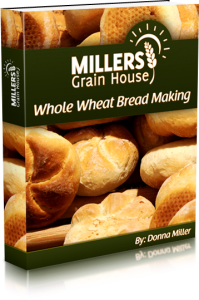 It is with the utmost of anticipation that I am delighted to announce the recent release of my newest e-book. As a better teacher, I can teach a class on this subject and everyone leave with a perfect loaf of bread, even if they’ve never touched whole wheat flour before. Live classes are my favorite! I love to see the joy and confidence on the faces of the participants as they take home their creations to share!
It is with the utmost of anticipation that I am delighted to announce the recent release of my newest e-book. As a better teacher, I can teach a class on this subject and everyone leave with a perfect loaf of bread, even if they’ve never touched whole wheat flour before. Live classes are my favorite! I love to see the joy and confidence on the faces of the participants as they take home their creations to share!
This book has been a labor of love for me. Usually in a class, I have the benefit of conversation and hands-on demonstration. In this book, I’ve endeavored to show and describe techniques and tips that we discuss, demonstrate and do in a live class together. I hope it helps you on your way to producing consistently tasty and beautiful loaves of whole wheat bread for your family!
You can follow this link to see what others say about it and get a copy of your own: Whole Wheat Bread Making
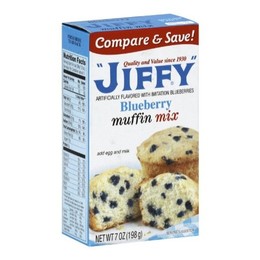 Do some of these convenience food mixes grace your shelves at home?
Do some of these convenience food mixes grace your shelves at home?
- Quaker Instant Flavored Oatmeal.
- Eggo Frozen Waffles.
- Aunt Jemima’s Frozen Pancakes.
- Jiffy Muffin Mix.
- Bisquick.
If so, for your health and the health of your family please take the time to read this article.
The most recent class I taught was on how to make each of these foods at home into a convenient mix-type method using whole grains and real, healthy ingredients. It occurred to me, while teaching class that many of us have picked these (or similar) items up out of habit or based on budget.
The truth is, we can make the mix itself at home, quickly with far healthier ingredients (omitting many of the killer ingredients) at a fraction of the cost. With home-made, whole grain, convenience mixes and making ample extras to freeze, you can increase the nutritional value of each serving and still save money without sacrificing time. After all, isn’t that why you’re using the convenience mix? To save time?
Each of the foods listed above include ingredients intended to extend the shelf-life. Become a label detective and take a look at what is hiding in the boxes that have a picture of real food on the cover.
Here are some of the top offenders you can omit by using a home-made mix:
- Enriched White Bleached Flour (Elmer’s Glue for the colon)
- Lard
- Hydrogenated Lard (as if Lard were not bad enough)
- Artificial Colors/Dyes
- Aluminum
- Artificial Flavor
- Partially Hydrogenated Soybean or Cottonseed Oil
- Calcium Carbonate (also known as chalkboard chalk)
- Sodium Sulfite
- “Fruit” is often sugar -bits with artificial flavoring (the list of fake ingredients is too long)
The more box foods eaten, the sooner you’ll be in a box of your own.
It is almost impossible to put into one blog post the best way to tackle this issue!! WE WANT TO HELP YOU! This is going to be a topic for several of the Free Online Classes! So if you are on our newsletter list (and you have the newsletter email in your approved contacts) you’ll be getting notices SOON of these Free Online classes! If you’re not sure if you’re on the Newsletter list, or you’ve changed email – go HERE.
It is my desire to show you just how simple some of these changes can be. They are cost effective and healthy changes that you can do easily at home and enJOY the journey!
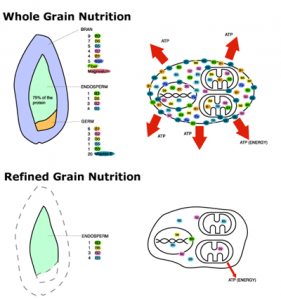 There is mounting and evidence of the health challenges associated with using refined white flour. It is staggering to the mind when you consider the overwhelming facts showing the problems and dangers of consuming refined white flour. I am convinced we must educate people if we are ever going to have a major impact on the health crisis that is facing the world.
There is mounting and evidence of the health challenges associated with using refined white flour. It is staggering to the mind when you consider the overwhelming facts showing the problems and dangers of consuming refined white flour. I am convinced we must educate people if we are ever going to have a major impact on the health crisis that is facing the world.
Studies have been done on many ailments since the processing (stripping for shelf purposes) of whole grains in the early 1900’s.
Gout, anemia, diabetes and depression are just a few of the ailments that are impacting people worldwide. These health concerns can all be linked to vitamin deficiencies that are missing in refined flours after the turn of the century. It’s a problem that we created for ourselves with the move toward the “convenience” of shelf flour.
The answer to many health issues is to use the whole grain as it was intended. Fresh, live and whole is what is best for your health, your body, and your energy. Most people can understand the logic that in order to improve “life” in your health, you need to consume live food. It takes no more time to mill your own flour at home with live whole wheat, than it does to gather the ingredients for pancakes.
Do your body and your family a favor by feeding them ALL the nutrients designed in grains rather than partial, processed and packed convenient ‘dead’ flours.
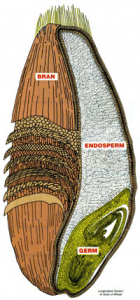 If you have read many of my articles on whole wheat and grains or have listened to my weekly radio show, you know that I am a strong advocate of using whole wheat. Years ago, I stopped purchasing bagged flour from the store because I believe the nutritional value of whole wheat is important for my family.
If you have read many of my articles on whole wheat and grains or have listened to my weekly radio show, you know that I am a strong advocate of using whole wheat. Years ago, I stopped purchasing bagged flour from the store because I believe the nutritional value of whole wheat is important for my family.
When you consider what is missing from bagged flour, you will understand the reason I am so supportive of milling fresh whole grains. Consider the following:
What nutrients are in a bag of flour that has been sitting on the shelf? We can take into consideration the fact that we know from what has been removed, it is NOT 100% of the nutrients as if the whole kernel were consumed. Continue reading
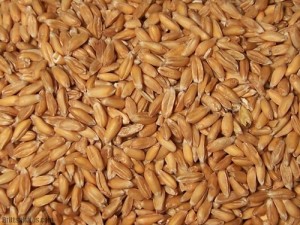 More people are beginning to experience the goodness of using whole grains. From the joy of smelling fresh baked breads in the kitchen, to the delicious taste of the end product, nothing quite compares to the goodness of whole grains. But the most important part for our family is the incredible nutritional value.
More people are beginning to experience the goodness of using whole grains. From the joy of smelling fresh baked breads in the kitchen, to the delicious taste of the end product, nothing quite compares to the goodness of whole grains. But the most important part for our family is the incredible nutritional value.
In order to get the most nutrition from whole grains there are a few very simply rules you should follow.
For Grain in the Hull:
- Keep in an air-tight container in a cool room below 80 degrees Fahrenheit.
- Keep free from humidity and be sure the container does not promote any condensation.
- Keep away from a direct heat source or direct sunlight.
For Freshly Milled Whole Grain Flour:
- Use immediately for peak nutrition
- Store any unused freshly milled flour for up 7 days at the next best optimum nutrition and up to 6 months before its spoiled.
- Fresh milled flour is susceptible to moisture in the air. Store immediately.
Whole Grain Flour – Store bought.
- This flour is already stripped of many oils and nutrients to give it a long shelf life.
- Store bagged flour in a dry place for up to one year.
- It is not and cannot become as nutritionally sound as freshly milled flour.
Once the grain is baked into a baked good, protect that goodness with a little more attention to storage. Whole grains tend to dry out faster than bleached or processed grains. You may want to store them in the refrigerator and you certainly will want to make sure they are stored in an airtight container or package.
Usually, in our home, once the grain is milled and then used, the items are not around long enough for them to spoil – we eat them too fast! To have the goodness of whole grains for a prolonged span of time, simply requires a little planning and protection.
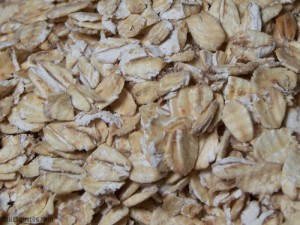 Oats are far more versatile than to simply be used for porridge or gruel. Whole Oats (usually Whole Rolled Oats) are a great source of protein, fiber, vitamins, and minerals. Whole oats have been proven to help reduce cholesterol levels and make a great healthy breakfast that will keep you contented all the way until lunch.
Oats are far more versatile than to simply be used for porridge or gruel. Whole Oats (usually Whole Rolled Oats) are a great source of protein, fiber, vitamins, and minerals. Whole oats have been proven to help reduce cholesterol levels and make a great healthy breakfast that will keep you contented all the way until lunch.
Oats are very seldom sold with the hull left on for eating. The whole oat grain is usually called “oat groats”, which is the least-processed form which can be used in the same ways you would use wheat kernels. Oat groats can be milled into flour or flaked into what we are used to as Old Fashioned Rolled Oats.
Steel Cut Oats are whole oat groats which have merely been roughly cut. Old-fashioned have been flattened and quick-cooking oats have been steamed a bit, cut and flattened to speed cooking process. Instant oatmeal has been rolled very thin and is already partially cooked. For nutrition (and some people would say for full texture), a thick rolled oat is the most full bodied option for a substantial oatmeal.
Because of their somewhat higher fat content, oats should be stored away from any heat or damp in an airtight container. The suggested storage time for oats is about three to six months.
In addition to porridge, oats can be used for stuffing, added to baked goods, or cooked whole and added to grain salads. Try using them in place of bread crumbs for meatloaf. Top a cobbler with a mixture of whole wheat flour, butter, sugar and whole oats. It’s also easy to make your own Granola!


